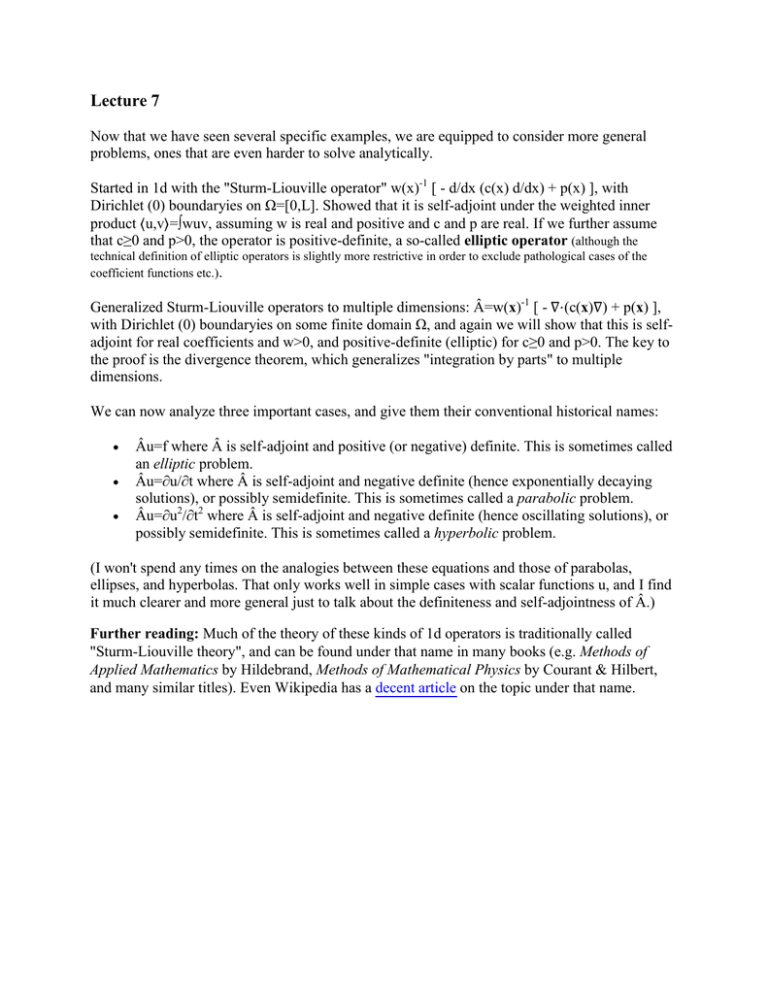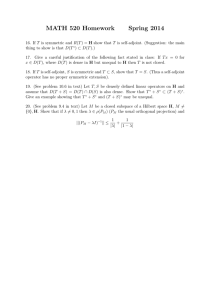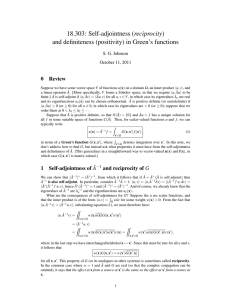Lecture 7
advertisement

Lecture 7 Now that we have seen several specific examples, we are equipped to consider more general problems, ones that are even harder to solve analytically. Started in 1d with the "Sturm-Liouville operator" w(x)-1 [ - d/dx (c(x) d/dx) + p(x) ], with Dirichlet (0) boundaryies on Ω=[0,L]. Showed that it is self-adjoint under the weighted inner product ⟨u,v⟩=∫wuv, assuming w is real and positive and c and p are real. If we further assume that c≥0 and p>0, the operator is positive-definite, a so-called elliptic operator (although the technical definition of elliptic operators is slightly more restrictive in order to exclude pathological cases of the coefficient functions etc.). Generalized Sturm-Liouville operators to multiple dimensions: Â=w(x)-1 [ - ∇⋅(c(x)∇) + p(x) ], with Dirichlet (0) boundaryies on some finite domain Ω, and again we will show that this is selfadjoint for real coefficients and w>0, and positive-definite (elliptic) for c≥0 and p>0. The key to the proof is the divergence theorem, which generalizes "integration by parts" to multiple dimensions. We can now analyze three important cases, and give them their conventional historical names: Âu=f where  is self-adjoint and positive (or negative) definite. This is sometimes called an elliptic problem. Âu=∂u/∂t where  is self-adjoint and negative definite (hence exponentially decaying solutions), or possibly semidefinite. This is sometimes called a parabolic problem. Âu=∂u2/∂t2 where  is self-adjoint and negative definite (hence oscillating solutions), or possibly semidefinite. This is sometimes called a hyperbolic problem. (I won't spend any times on the analogies between these equations and those of parabolas, ellipses, and hyperbolas. That only works well in simple cases with scalar functions u, and I find it much clearer and more general just to talk about the definiteness and self-adjointness of Â.) Further reading: Much of the theory of these kinds of 1d operators is traditionally called "Sturm-Liouville theory", and can be found under that name in many books (e.g. Methods of Applied Mathematics by Hildebrand, Methods of Mathematical Physics by Courant & Hilbert, and many similar titles). Even Wikipedia has a decent article on the topic under that name. MIT OpenCourseWare http://ocw.mit.edu 18.303 Linear Partial Differential Equations: Analysis and Numerics Fall 2014 For information about citing these materials or our Terms of Use, visit: http://ocw.mit.edu/terms.






